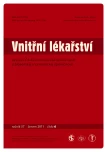Primary hepatic carcinoid
Authors:
J. Plášek 1; M. Vybíralová 2; J. Dvořáčková 3; A. Petrušková 4; J. Sagan 5; M. Golián 6; V. Hrabovský 1; N. Petejová 1; Arnošt Martínek 1
Authors‘ workplace:
Interní klinika Lékařské fakulty Ostravské Univerzity a FN Ostrava, přednosta doc. MUDr. Arnošt Martínek, CSc.
1; Onkologická klinika Lékařské fakulty Ostravské Univerzity a FN Ostrava, přednosta prim. MUDr. David Feltl, Ph. D., MBA
2; Ústav patologie Lékařské fakulty Ostravské Univerzity a FN Ostrava, přednostka prim. MUDr. Jana Dvořáčková, Ph. D.
3; Klinika nukleární medicíny Lékařské fakulty Ostravské Univerzity a FN Ostrava, přednosta prim. MUDr. Otakar Kraft, Ph. D., MBA
4; Klinika infekčního lékařství Lékařské fakulty Ostravské Univerzity a FN Ostrava, přednosta prim. MUDr. Luděk Rožnovský, CSc.
5; Radiodiagnostický ústav Lékařské fakulty Ostravské Univerzity a FN Ostrava, přednostka prim. MUDr. Alena Jahodová
6
Published in:
Vnitř Lék 2011; 57(6): 590-594
Category:
Case Reports
Overview
Primary hepatic carcinoid (PHC) is considered to be particularly sporadic diagnosis; in current literature about 60 cases have been reported. Most of the patients present with abdominal pain, diarrhea, icterus, flush, weight loss or respiratory disease; even though the course of the disease might stay asymptomatic for a long time. An illuminating case of at presentation oligosymptomatic 65-year-old patient, which was after extensive examination based on Octreoscan and histological verification diagnosed to have PHC, is reported. Paliative therapy with somatostatine analogues followed. At autopsy 8 months later the clinical diagnosis of PHC was confirmed. PHC is difficult to diagnose both due to radiological similarity to other hepatic lesions and demanding exclusion of other primary foci. The diagnosis of PHC is based on negative imaging techniques result in other possible localizations. Minimal symptomatology in stage of generalization, atypical primary localization and rapid progression is of interest in current case.
Key words:
carcinoid – octreoscan – 5-HIAA – Sandostatin LAR
Sources
1. Zamrazil V. Neuroendokrinní (difuzní endokrinní) systém a nádory, které z něho vycházejí. In: Stárka L et al (eds). Pokroky v endokrinologii. Praha: Maxdorf 2007.
2. Cempírková V, Havránek P. Karcinoid. Vnitř Lék 2005; 51 : 1011–1018.
3. Louthan O. Neuroendokrinní nádory, klinické pohledy. 1. vyd. Praha: Grada publishing 2006.
4. Klöppel G, Perren A, Heitz PU. The gastroenteropancreatic neuroendocrine cell system and its tumors: the WHO classification. Ann NY Acad Sci 2004; 1014 : 13–27.
5. Solcia E, Kloeppel G, Sobin LH. Histological Typing of Endocrine Tumors. 2nd ed. Berlin, Heidelberg, Germany: Springer-Verlag 2000.
6. Caplin ME, Buscombe JR, Hilson AJ et al. Carcinoid tumor. Lancet 1998; 352 : 799–805.
7. Modlin IM, Sandor A. An analysis of 8,305 cases of carcinoid tumors. Cancer 1997; 79 : 813–829.
8. Rea F, Binda R, Spreafico G et al. Bronchial carcinoids. A review of 60 patients. Ann Thorac Surg 1989; 47 : 412–414.
9. Vítek P, Rozina J, Pála M. Terapie karcinoidu a karcionoidnho syndromu. Farmakoterapie 2005; 4 : 356–365.
10. Touloumis Z, Delis SG, Triantopoulou CH et al. Primary hepatic carcinoid; a diagnostic dilemma: a case report. Cases J 2008; 1 : 314.
11. Modlin IM, Lye KD, Kidd M. A 5-decade analysis of 13,715 carcinoid tumors. Cancer 2003; 97 : 934–959.
12. Jager RM, Polk HC Jr. Carcinoid apudomas. Curr Probl Cancer 1977; 1 : 1–53.
13. Edmondson HA. Carcinoid tumor. In: Edmondson HA (ed.). Tumors of the liver and intrahepatic bile ducts (Atlas of Tumor Pathology). Washington: Armed Forces Institute of Pathology 1958 : 105–111.
14. Modlin IM, Shapiro MD, Kidd M. An analysis of rare carcinoid tumors: clarifying these clinical conundrums. World J Surg 2005; 29 : 92–101.
15. Gravante G, De Liguori Carino N, Overton J et al. Primary carcinoids of the liver: a review of symptoms, diagnosis and treatments. Dig Sur 2008; 25 : 364–368.
16. Shi W, Johnston CF, Buchanan KD et al. Localization of neuroendocrine tumours with [111In] DTPA-octreotide scintigraphy (Octreoscan): a comparative study with CT and MR imaging. QJM 1998; 91 : 295–301.
17. Modlin IM, Kidd M, Latich I et al. Current status of gastrointestinal carcinoids. Gastroenterology 2005; 128 : 1717–1751.
18. Oberg K, Eriksson B. Nuclear medicine in the detection, staging and treatment of gastrointestinal carcinoid tumours. Best Pract Res Clin Endocrinol Metab 2005; 19 : 265–276.
Labels
Diabetology Endocrinology Internal medicineArticle was published in
Internal Medicine

2011 Issue 6
Most read in this issue
- Brugada syndrome
- Primary hepatic carcinoid
- Seniors and cardiovascular medications
- Long-term outcome of catheter ablation therapy of supraventricular tachyarrhythmias
